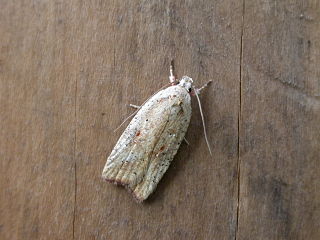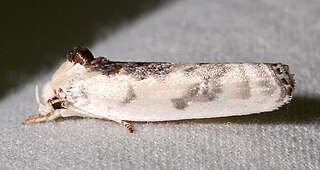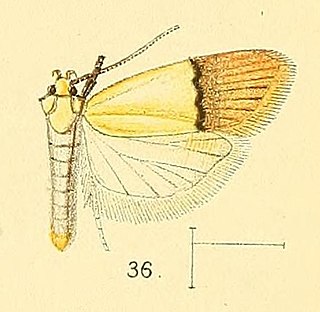
The Gelechiidae are a family of moths commonly referred to as twirler moths or gelechiid moths. They are the namesake family of the huge and little-studied superfamily Gelechioidea, and the family's taxonomy has been subject to considerable dispute. These are generally very small moths with narrow, fringed wings. The larvae of most species feed internally on various parts of their host plants, sometimes causing galls. Douglas-fir (Pseudotsuga) is a host plant common to many species of the family, particularly of the genus Chionodes, which as a result is more diverse in North America than usual for Gelechioidea.

Copromorphidae, the "tropical fruitworm moths", is a family of insects in the lepidopteran order. These moths have broad, rounded forewings, and well-camouflaged scale patterns. Unlike Carposinidae the mouthparts include "labial palps" with the second rather than third segment the longest. With other unusual structural characteristics of the caterpillar and adult, it could represent the sister lineage of all other extant members of this superfamily. The genus Sisyroxena from Madagascar is also notable for its unusual venation and wing scale sockets.

Urodidae, whose species are commonly known as false burnet moths, is a family of moths in the lepidopteran order. It is the type genus in the superfamily, Urodoidea, with three genera, one of which, Wockia, occurs in Europe.

Pterolonchidae is a small family of very small moths in the superfamily Gelechioidea. There are species native to every continent except Australia and Antarctica.

Aristotelia is a genus of moths in the family Gelechiidae. Well-known species are food plant specialists, and diverse hosts are used – Salicaceae, Solanaceae, Rosaceae, Fagaceae, Fabaceae, Asteraceae.

Holcocera is a gelechoid moth genus of the family Blastobasidae. There are about 70 described species.

The gorse tip moth is a smallish moth species of the family Depressariidae.

Antaeotricha is a genus of moths. It is the largest genus in the subfamily Stenomatinae, numbering over 400 species in the Western Hemisphere.

Coleophora atriplicis is a moth of the family Coleophoridae found in Europe and North America.

Agonopterix is a moth genus of the superfamily Gelechioidea. It is placed in the family Depressariidae, which was often – particularly in older treatments – considered a subfamily of the Oecophoridae or included in the Elachistidae.

Autosticha is a genus of gelechioid moths. It belongs to the subfamily Autostichinae, which is either placed in the concealer moth family (Oecophoridae), or in an expanded Autostichidae. It is the type genus of its subfamily. Originally, this genus was named Automola, but this name properly refers to a fly genus in family Richardiidae.

Xyloryctidae is a family of moths contained within the superfamily Gelechioidea described by Edward Meyrick in 1890. Most genera are found in the Indo-Australian region. While many of these moths are tiny, some members of the family grow to a wingspan of up to 66 mm, making them giants among the micromoths.
Meridarchis is a genus of moths in the family Carposinidae erected by Philipp Christoph Zeller in 1867.

Odites is a genus of moths in the family Depressariidae. Most species of this genus are found in Asia and in Africa.

Gelechiinae is a subfamily of moths in the family Gelechiidae. It was described by Henry Tibbats Stainton in 1854.
Aristotelia isopelta is a moth of the family Gelechiidae. It was described by Edward Meyrick in 1929. It is found in North America, where it has been recorded from Arizona, British Columbia, California, Indiana, Maine, Massachusetts, Quebec and Texas.
Aristotelia ochroxysta is a moth of the family Gelechiidae. It was described by Edward Meyrick in 1929. It is found in North America, where it has been recorded from Texas.
Glyphidocera barythyma is a moth in the family Autostichidae. It was described by Edward Meyrick in 1929. It is found in North America, where it has been recorded from Florida, Indiana and Texas.
Glyphidocera democratica is a moth in the family Autostichidae. It was described by Edward Meyrick in 1929. It is found in North America, where it has been recorded from Alabama, Arkansas, Florida, Kentucky, Louisiana, Mississippi, North Carolina, Tennessee, Texas and West Virginia.
Filinota vociferans is a moth in the family Depressariidae. It was described by Edward Meyrick in 1930. It is found in Rio de Janeiro, Brazil.













